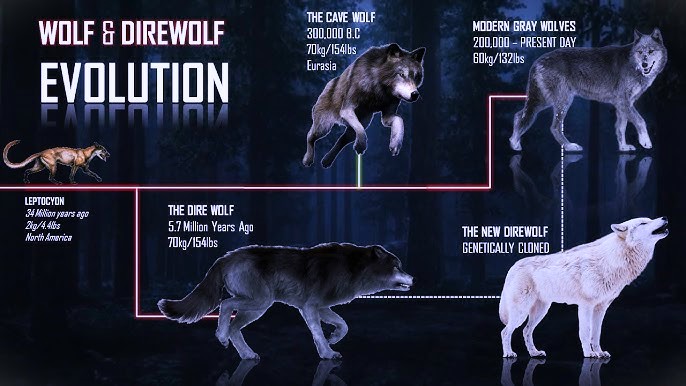In April 2025, the world was abuzz with news of the “DIRE Wolf”—a term that has emerged in public discourse to describe the genetically engineered dire wolf pups created by Colossal Biosciences, a Dallas-based biotechnology company. The announcement of three dire wolf pups, named Romulus, Remus, and Khaleesi, marked a significant milestone in the field of de-extinction. However, it also sparked heated debates among scientists, conservationists, and the public.
What is the DARE Wolf?
The term “DIRE Wolf” is a colloquial shorthand for the Dire wolf Assisted by Reverse Extinction, referring to the dire wolf (scientifically named Aenocyon dirus), an iconic predator that roamed North and South America from around 250,000 to 13,000 years ago. Dire wolves were larger than modern gray wolves, with bigger heads and stronger jaws adapted for hunting large prey like bison and horses. They went extinct around 13,000 years ago, likely due to habitat loss and the disappearance of their prey, compounded by human activity.
Colossal Biosciences announced on April 7, 2025, that they had “resurrected” the dire wolf by creating three pups through genetic engineering. The process involved extracting ancient DNA from dire wolf fossils—a 72,000-year-old ear bone and a 13,000-year-old tooth—and using the gene-editing tool CRISPR-Cas9 to modify the genome of a modern gray wolf (Canis lupus). The company made 20 edits across 14 genes to give the pups dire wolf-like traits, such as larger size, snow-white fur, bigger skulls, and stronger teeth. The edited embryos were implanted into dog surrogate mothers, resulting in the birth of the three pups.
However, the scientific community has questioned whether these pups are truly dire wolves. Geneticists argue that the pups are essentially gray wolves with dire wolf-like traits, as the edits affect only a tiny fraction of the gray wolf’s 2.447 billion base-pair genome. A preprint paper by Colossal Biosciences, published on April 11, 2025, revealed that the dire wolf and gray wolf genomes are 99.94% identical, meaning the differences are minimal. Critics argue that this does not constitute a true de-extinction but rather the creation of a new, genetically modified animal.
Why is the DIRE Wolf in the News?

The DIRE Wolf has captured global attention for several reasons:
1. A Milestone in De-Extinction Technology
Colossal Biosciences has framed the DIRE Wolf project as a groundbreaking achievement in de-extinction science. The company’s ability to extract and sequence ancient DNA, edit genes with CRISPR, and successfully produce living pups demonstrates significant advancements in biotechnology. Sophie Turner, known for her role as Sansa Stark in Game of Thrones, expressed her awe on May 3, 2025, calling it “a monumental moment, not just for the return of the iconic dire wolf, but for science, for conservation, and for everyone who’s ever dreamed of the impossible.” Her emotional response, shared on Instagram, resonated with fans of the show, where dire wolves are a prominent symbol.
2. Cultural Impact and Hollywood Ties
The dire wolf’s revival has a strong connection to popular culture, particularly Game of Thrones, where dire wolves are depicted as majestic companions to the Stark family. Colossal Biosciences leaned into this connection by naming one of the pups Khaleesi (after Daenerys Targaryen’s title) and photographing two pups, Romulus and Remus, on the Iron Throne prop used by HBO. The project also attracted high-profile investors like Game of Thrones author George R.R. Martin and filmmaker Peter Jackson, adding a Hollywood flair to the scientific endeavor. This cultural resonance has amplified public interest, with the internet reacting with awe, as reported by the BBC.
3. Scientific and Ethical Controversies
While the public has been captivated by the DIRE Wolf, scientists and conservationists have raised significant concerns:
- Authenticity Debate: Many experts argue that the DIRE Wolf is not a true dire wolf but a genetically modified gray wolf. A 2021 study, bolstered by Colossal’s recent findings, suggests that dire wolves diverged from gray wolves around 4.5 million years ago, sharing a common ancestor with jackals and other canids. The 20 genetic edits made by Colossal are a small fraction of the differences between the species, leading to skepticism about the claim of de-extinction. On Reddit, users have echoed this sentiment, calling the pups “gray wolves with dire wolf-like traits.”
- Conservation Priorities: The International Union for Conservation of Nature (IUCN) and other groups worry that the focus on de-extinction detracts from more pressing conservation efforts. For example, Colossal also cloned two litters of red wolves, a critically endangered species with only 16 individuals left in the wild, but this achievement received far less attention. Critics argue that resources should be directed toward saving existing species, such as gray wolves, whose protections in the U.S. have recently been rolled back, rather than reviving long-extinct ones.
- Ecological Risks: Scientists have warned of “unintended consequences” from introducing genetically modified animals into ecosystems. The DIRE Wolf pups, with only three individuals, lack the genetic diversity to form a viable population, and their ecological role is uncertain. Some fear that such projects could undermine public support for conservation by creating a false sense that extinct species can be brought back, reducing the urgency to protect living ones.
4. Broader Implications for Biotechnology
The DIRE Wolf project has sparked discussions about the future of biotechnology in conservation. Colossal Biosciences claims that their technologies, which are open-source, can be used to restore lost genes in endangered populations or develop disease-resistant traits. The company is also working on de-extincting other species, such as the woolly mammoth and the Tasmanian tiger, raising questions about the ethical and practical implications of such efforts. For instance, could this technology be used to revive more recently extinct species, like the northern white rhino, as scientists are attempting with IVF and frozen sperm?

The Bigger Picture: De-Extinction vs. Conservation
The DIRE Wolf saga highlights a fundamental tension in modern biology: the allure of de-extinction versus the urgent need for conservation. On one hand, the technology developed by Colossal Biosciences could revolutionize conservation by enabling the restoration of lost genetic diversity. On the other hand, critics argue that it distracts from more immediate crises, such as the imminent extinction of species like the red wolf. As one scientist put it, “By all means, develop the technology, but use it to conserve and save what we’ve got left.”
Moreover, the project raises philosophical questions about humanity’s role in shaping nature. The ability to edit genomes and “resurrect” extinct species gives humans godlike powers, as some commentators have noted, but it also comes with little accountability. The DARE Wolf pups may be a scientific marvel, but their creation prompts us to ask: Should we be doing this? And at what cost?
The DIRE Wolf is more than just a scientific experiment—it’s a cultural phenomenon, a technological milestone, and a lightning rod for debate. While Colossal Biosciences celebrates the birth of Romulus, Remus, and Khaleesi as a step toward a future where extinction is reversible, many in the scientific community remain skeptical. The project underscores the need for a balanced approach to biotechnology, one that leverages innovation to address current ecological crises rather than chasing the spectacle of reviving long-lost species. As the debate continues, the DIRE Wolf serves as a reminder of both the promise and peril of humanity’s quest to rewrite the story of life on Earth.















